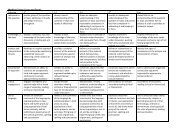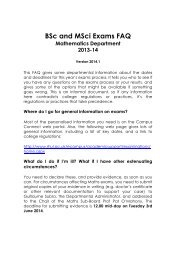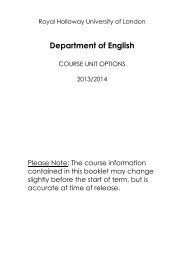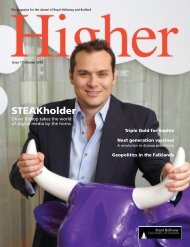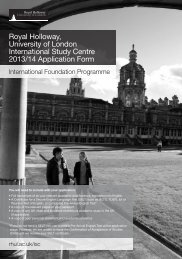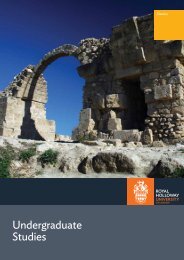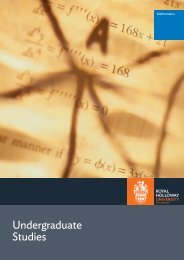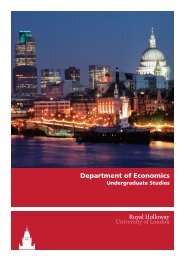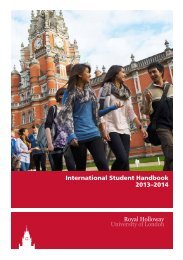Operating and <strong>Financial</strong> Review(continued)level <strong>of</strong> deposit to secure a place is being implemented to reduceuncertainty about the number <strong>of</strong> students who will enrol. The firstcount <strong>of</strong> student enrolments for <strong>2011</strong>-12 indicates that overseasstudent numbers have increased by 414 FTEs compared to 2010-11,but these are subject to finalisation as numbers settle. In 2010-11,40% <strong>of</strong> overseas students were from China and Hong Kong. TheCollege’s overseas recruitment strategy is targeting an increase inthe level <strong>of</strong> diversification by country.Total income is at a similar level to 2009-10. This reflects a cutin HEFCE recurrent grant funding and the drop in income fromoverseas students <strong>of</strong>fset by increases in other areas, includingresearch grant and contract income. Over a five-year period therehas been substantial growth in income, which has increased from£104.9m in 2006-07 to £132.2m in 2010-11. In 2010-11 teachingcontributed 52% to total income and research income was 22% <strong>of</strong>the total (figure 4).Figure 4: Annual income by major category (£’000)140,000120,000100,00080,00060,00040,00020,00002006/07 2007/08 2008/09 2009/10 2010/11Teaching Research Endowment & Investment OtherWhere “teaching” is defined as HEFCE teaching grant plus tuitionfees and contracts and “research” is HEFCE research grant andresearch grants and contractsFigure 5: Annual surplus as a proportion <strong>of</strong> income (£’000)8.0%7.0%6.0%5.0%4.0%3.0%2.0%1.0%0.0%2006-07 2007-08 2008-09 2009/-10 2010-11% SurplusIn figure 5, the financial surplus as a proportion <strong>of</strong> income is set outfor the last five years. In each year it has exceeded 3% <strong>of</strong> income,and was 5.0% in 2010-11, compared to 4.5% in the previousyear. This improvement was partly due to savings in staff costsas a result <strong>of</strong> voluntary severances agreed in 2009-10, as well asfrom a lower cost <strong>of</strong> staff restructuring compared to 2009-10.The surpluses provide funds for investment in the College estateand infrastructure.Major changes to government funding and fees for UK (home)and EU students are being introduced from 2012-13. TheCollege has decided to charge fees <strong>of</strong> £9,000 for all subjectsand its arrangements for providing support to students havebeen approved by OFFA (the Office for Fair Access). Underthese arrangements bursary support to students, together withexpenditure on outreach and student retention activities, is plannedto increase to over £5m by 2014/15, compared to £2.7m currently.Following the agreement <strong>of</strong> these arrangements, HEFCE announcedchanges to the controls over the number <strong>of</strong> students HEIs canadmit in 2012-13. This includes the removal <strong>of</strong> any caps on therecruitment <strong>of</strong> students with A-level (or equivalent) qualifications<strong>of</strong> AAB or better and a reduction <strong>of</strong> 8% to adjusted core intakenumbers. The places removed by this reduction will then bereallocated through a bidding process available to HEIs chargingnet fees <strong>of</strong> £7,500 or less. An extension <strong>of</strong> these policies is to beexpected over the following two years.The College is analysing the possible effect <strong>of</strong> these changes. Theimpact will vary by subject area depending on their normal A-levelentry levels, their competitive position and the behaviour <strong>of</strong> otherHEIs in targeting the recruitment <strong>of</strong> AAB+ students. In addition thetariff level for uncapped recruitment may be reduced after 2012-13.During the year, the new Principal, Paul Layzell, has developed aManifesto through a process <strong>of</strong> consultation and this was agreed byCouncil in April <strong>2011</strong>. The Manifesto confirms the College’s strategyto be in the top tier <strong>of</strong> UK universities and sets out the principlesand priorities necessary to maintain and strengthen this position.The changes and uncertainties affecting the funding environmentthat have been described reinforce the priorities that have beenset out in the Manifesto to strengthen academic excellence, toimprove the student experience and to make investments thatsupport these.A strategic review <strong>of</strong> the academic portfolio has been completedand a consultation is being undertaken on proposed changes toModern Languages, Classics and Computer Science. The overall aimis to achieve sustainable academic activity with departments thatare able to recruit the best-performing students and achieve thebest research outputs. In addition pr<strong>of</strong>essional services are beingreviewed and a number <strong>of</strong> changes will take place in the comingyear, supported by investment in systems and procedures, toimprove service delivery to students and others.A number <strong>of</strong> initiatives with private sector organisations are beingdeveloped. A foundation programme for international studentswill be provided by Study Group International, with an initial smallintake in <strong>2011</strong>-12. This is intended to increase the intake <strong>of</strong> overseasstudents, who will progress from the foundation programme toundergraduate study, and to diversify the markets from whichthey are recruited and the subjects they study. The College has4
Operating and <strong>Financial</strong> Review(continued)reached an initial agreement with Pearson Education, part <strong>of</strong> thePearson Group, to validate a degree in business with the intention<strong>of</strong> broadening this agreement to other subject areas. In additionthe College is in advanced discussions to provide teaching toundergraduate programmes in Management in collaborationwith a private sector organisation in Singapore. These activitieswill diversify and increase income and will also provide valuableexperience and know-how <strong>of</strong> working with organisations whooperate with different business models.Within the HE sector the College is engaged in a number<strong>of</strong> institutional and academic collaborations. The two mostestablished, the South West <strong>London</strong> Academic Network (SWan)and the South East Physics Network (SEPNet), have both beensupported from HEFCE Strategic Development Funds. SWan isbeing restructured to focus specifically on the development <strong>of</strong>‘added value’ research collaborations between the three partners(<strong>Royal</strong> <strong>Holloway</strong>, St George’s and Kingston <strong>University</strong>). SEPNetcontinues to flourish as a network supporting research andteaching collaborations amongst the partner institutions as wellas playing a crucial role in communicating the value <strong>of</strong> Physicsto potential university students and employers. More recentpartnership agreements have been signed with the VeterinaryLaboratory Agency and the National Physics Laboratory, bothfocussed on developing research and teaching links.An extension to the School <strong>of</strong> Management which providesadditional postgraduate teaching space has been completed for thestart <strong>of</strong> the <strong>2011</strong>-12 session, together with a refurbishment <strong>of</strong> theStudents’ Union building. A new Drama theatre has been designedand is programmed to be completed for 2012-13, together withrefurbishment <strong>of</strong> existing space. A major addition to studentlibrary and learning resource space is being planned, potentially for2013-14, and options for additional student residences are beingconsidered. The College has continued its dialogue to developa new master-plan for the campus with Runnymede BoroughCouncil. This now depends on the adoption <strong>of</strong> a new core planningstrategy by the Council, something which is not expected to beformulated until 2013.The College is committed to the principles and practices <strong>of</strong>sustainable development, and has a 5-year Sustainability StrategicPlan and a Carbon Management Plan. It has successfully completedthe required Carbon Reduction Commitment (CRC) reportingand has achieved accreditation under the CRC Energy EfficiencyScheme Early Action Metric. A programme <strong>of</strong> investment in energymetering is being rolled out across the campus. The School <strong>of</strong>Management Extension achieved a BREEAM (Building ResearchEstablishment Environmental Assessment Method) Very Goodrating. Recycling bins have been installed in academic and <strong>of</strong>ficeareas and recycling rates have increased in the last year. A network<strong>of</strong> recycling champions is being recruited and an awarenesscampaign and training for staff and students to promoteenvironmentally-friendly practices are being planned.The College assesses risk, and both strategic and operational riskregisters are maintained. Risk mitigation plans are developed andresults are monitored.Pr<strong>of</strong>essor Paul Layzell was appointed as Principal from 16th August2010. Deputy Principal Pr<strong>of</strong>essor Rob Kemp was Acting Principalfrom 1st August 2009 until then. Pr<strong>of</strong>essor Layzell was formerlyDeputy Vice-Chancellor at Sussex <strong>University</strong>.<strong>Financial</strong> ReviewScope <strong>of</strong> the <strong>Financial</strong> <strong>Statements</strong>The financial statements comprise the consolidated results <strong>of</strong> theCollege (including funds for which the College is a trustee) andits subsidiary company <strong>Royal</strong> <strong>Holloway</strong> Enterprise Limited. Theresults <strong>of</strong> <strong>Royal</strong> <strong>Holloway</strong> Students’ Union (RHSU) are consolidatedup to 13 April <strong>2011</strong>. On this date RHSU registered as a separatecharity with new constitutional arrangements and an independenttrustee board, and it has been assessed that from this point RHSUno longer satisfies the conditions for its financial results to beconsolidated through the exercise <strong>of</strong> dominant influence overRHSU. This change in treatment is shown as a deemed disposal inthe financial statements.Results for the YearThe consolidated results for the year ended 31 July <strong>2011</strong> arepresented in these <strong>Financial</strong> <strong>Statements</strong>. In summary, theconsolidated results were:2010-11 2009-10£000 £000Income 132,204 132,121Expenditure 125,568 126,184Surplus 6,636 5,937In 2010-11, total income was little changed from 2009-10, with anincrease <strong>of</strong> £0.1m while expenditure fell slightly by £0.6m. After taxand adjusting for income transferred to accumulated income withinendowments and the transfer out <strong>of</strong> the RHSU reserves <strong>of</strong> £0.9m,the surplus retained within general reserves was £5.7m comparedto £5.9m for 2009-10.HEFCE GrantsIncome from the Higher Education Funding Council for England(HEFCE) decreased by £0.2m (0.4%) to £41.1m. The recurrentteaching grant was reduced by £1.1m but the overall decreasewas <strong>of</strong>fset by an increase in Specific Grant Income <strong>of</strong> £0.9m, inparticular the recognition <strong>of</strong> income from the Higher EducationInnovation Fund (HEIF).Tuition FeesIncome from tuition fees and education contracts decreased by£1.1m (2.3%) to £47.3m from £48.4m in 2009-10. There wasa 13% decrease in overseas student FTEs to 1,598 FTEs, withoverseas fee income falling by £2.1m. Overall, student FTEs fell by2.8% to 8,571, with Home/EU student FTEs <strong>of</strong> 6,973 at the samelevel as the previous year.5




